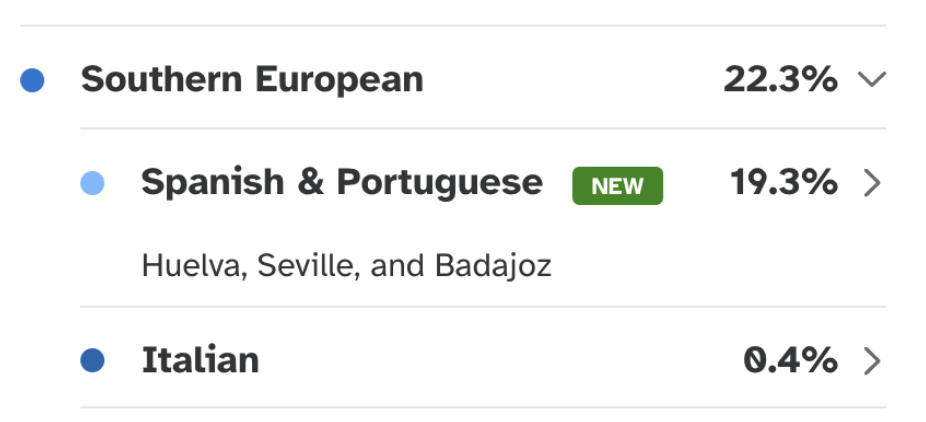23andMe has added finer detail for customers with roots that trace back to Spain and Portugal.
This update is part of our continuing work to improve our Ancestry reports and features. It will also allow customers with ancestry from those regions to see connections back to 43 genetic groups. These groups include 29 in Spain (including the Canary and Balearic archipelagos). In addition there are another 14 in Portugal (including the Azores and Madeira archipelagos). The update will affect about 10 percent of our customers who tested on our latest genotyping chip.
Spain and Portugal’s long colonial history means that many individuals with roots in the Americas may also see how those trace back to the Iberian Peninsula. Spain and Portugal have distinct and rich cultures and histories, but their histories also intertwine. Part of that history includes centuries of exploration, colonization, and trade, including the slave trade.
Iberian Peninsula
Bordering the Atlantic and at the mouth of the Mediterranean, the history of the people of the Iberian Peninsula is marked by their ocean-going explorations and influences from North Africa. The Moors ruled the peninsula for almost 800 years, and this influence can still be seen in both Spain and Portugal. But even older influences from the Greeks, Phoenicians, and Romans, are apparent. Each of these cultures have left a distinct imprint on the culture and history of the Iberian peninsula.
Ancestry Composition Update
23andMe’s Ancestry Composition report is a living analysis that improves as we add new reference data. Underlying our Ancestry reports are powerful algorithms and analytical tools developed by 23andMe population geneticists and engineers to offer our customers more insights into their ancestral origins.
Over the last few years, we’ve updated results for people with African Ancestry, Chinese ancestry, Indigenous American ancestry, and Latinx ancestry, for instance. Customers may already see evidence of recent ancestry from the Iberian Peninsula. However, this update and these genetic groups represent improvements in accuracy. They are also more reflective of the distinct regional populations and customers’ ancestry.
Regions in Spain and Portugal
In this update, the new methodology and algorithms use data from groups of people of Spanish or Portuguese ancestry with grandparents from specific regions in the Iberian Peninsula, and some of these regions overlap. Using this method we can connect customers with Portuguese or Spanish ancestry to those regional genetic groups through their shared DNA.

For 23andMe customers with Portuguese ancestry, the update most commonly includes matches to the regions of Porto, Minho, and Via Real, as well as Central and Southern Portugal and Madeira. The least common regions for matching are Terceira, Santa Maria and Flores, Corvo, and Graciosa in the Azores.
For customers with Spanish ancestry the most common matches will be to Western Andalusia (near Huelva, Seville, and Badajoz). Also customers with Spanish ancestry will more commonly see Southern Andalusia (near Cadiz), as well as to the Canary Islands matches. The least common regions are Galician and Basque associated regions in northern Spain.
More on Matching
Among customers on the latest genotyping chip, V5, who have more than 95 percent of their ancestry from the Iberian peninsula, around 40 percent will match with at least one Portuguese genetic group. Similarly, for customers on the latest chip with over 75 percent of their ancestry from the Iberian peninsula, approximately 40 percent will be matched to at least one Spanish genetic group.
Matching to one of these genetic groups means that you share a high genetic similarity with people in that group. Some regions overlap. But we’ve distinguished each geographically and descriptively. The names of these genetic groups also attempt to indicate the geographic regions.
Customers may receive a likely or highly likely match to one of these genetic groups. However, this update does not provide more breakdowns for customers’ Spanish and Portuguese ancestry percentages.
Your ancestry matters for your health
Many people find value in learning about their cultural roots but understanding your ancestry can also help you better understand your health. Your health and your likelihood of developing certain conditions involves several factors. These factors include your environment, family history and lifestyle. However, your genetics also plays an important role.
In some cases, that can be specific to the unique history of our ancestral groups.
So, for example, V30M, a genetic variant associated with TTR-related hereditary amyloidosis is more common among people of Portuguese ancestry. It’s also common in people of Northern Swedish and Japanese ancestry. The condition causes a buildup of a protein called transthyretin (TTR) in the body’s tissues and organs. That build up can damage the nerves, the heart, or other organs in the body.
People of Iberian descent have a higher likelihood of having one of the genetic variants linked to alpha 1 antitrypsin deficiency. Alpha 1 antitrypsin deficiency is a genetic condition that can lead to lung and liver disease
Find out more
23andMe customers who want to learn more about their Ancestry Composition can go here.
Not yet a customer?
Find out more about 23andMe’s Ancestry service and other services offered to customers here.




